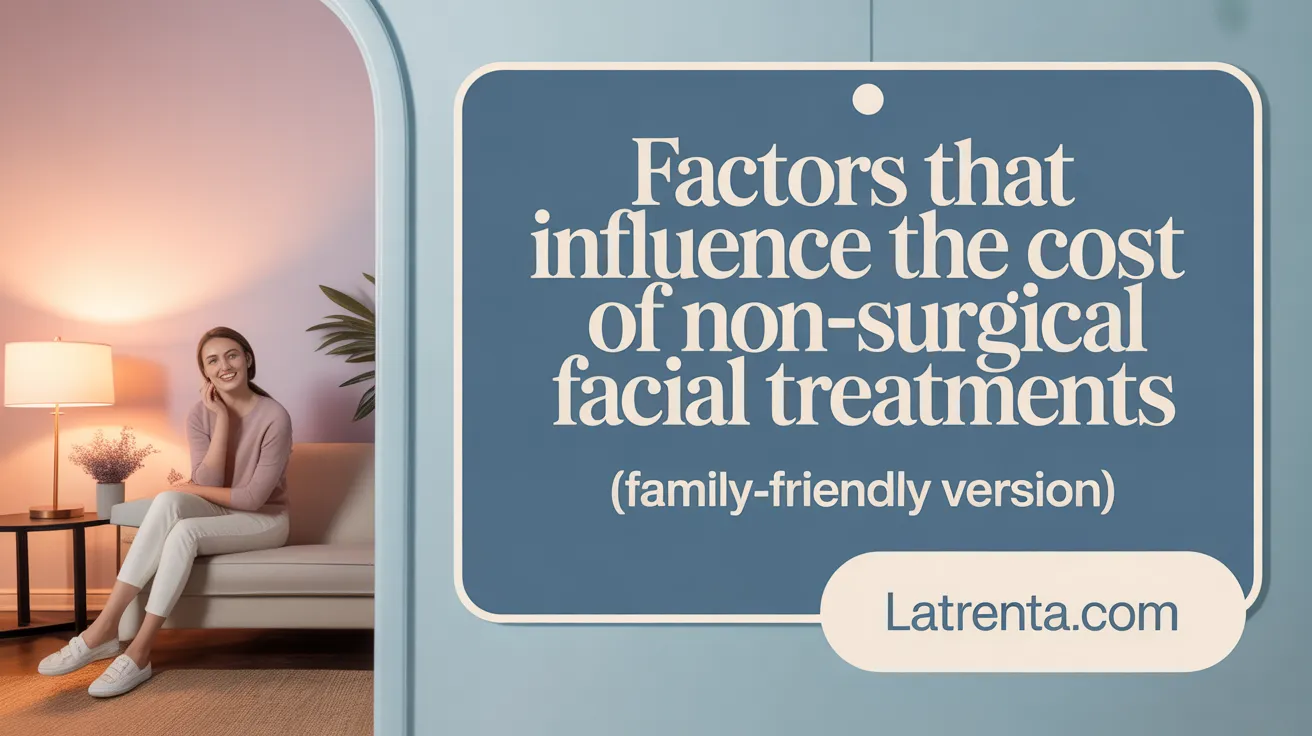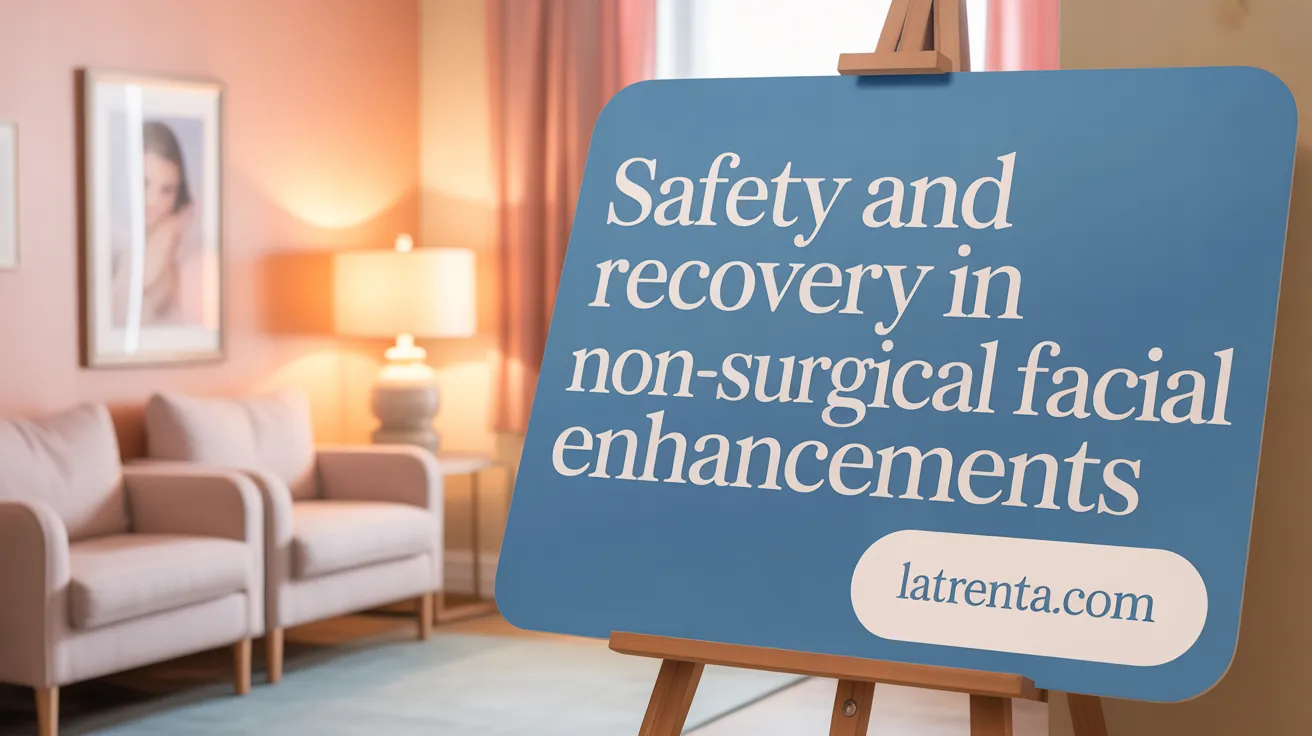Unveiling the Truth Behind Non-Surgical Facial Rejuvenation
As the demand for youth-preserving treatments surges globally, non-surgical facial enhancements have become a popular choice for those seeking subtle, natural-looking improvements without the downtime of surgery. This article explores the real costs, risks, benefits, and mechanisms behind these minimally invasive procedures, helping readers understand whether they are a worthwhile investment and how to choose the best options for their aesthetic needs.
Benefits and Limitations of Non-Surgical Facial Enhancements

What are the overall benefits and limitations of non-surgical facial enhancements?
Non-surgical facial enhancements have become increasingly popular as a versatile option for those seeking to improve their appearance without undergoing invasive procedures. These treatments offer the advantage of minimal downtime, allowing patients to return to their daily routines within a day or two. They are generally more affordable than surgical options, with procedures such as Botox, dermal fillers, laser resurfacing, and microneedling costing significantly less upfront.
One of the main benefits is their ability to provide natural-looking, subtle improvements. Patients often see firmer skin, reduction in fine lines and wrinkles, and increased facial volume, contributing to a refreshed appearance. Since most treatments are non-invasive or minimally invasive, risks of complications like scarring or significant nerve damage are low, especially when performed by trained professionals.
However, non-surgical rejuvenation has its limitations. The results tend to be temporary, typically lasting between 6 months to 2 years, necessitating ongoing maintenance treatments. They also generally do not address deep wrinkles, severe skin sagging, or extensive facial aging. For individuals with significant skin laxity or advanced aging signs, surgical procedures like facelifts may be more effective.
Furthermore, while side effects are usually mild and temporary—such as swelling, bruising, or redness—there is a chance of allergic reactions or skin irritation, particularly with fillers or chemical peels. So, patient selection and practitioner skill are critical in achieving optimal safety and results.
In summary, non-surgical facial enhancements are a less invasive, cost-effective way to improve appearance, suitable for those with early signs of aging and seeking subtle changes. Their limitations in durability and scope mean that they are often most effective when combined with or used as a precursor to surgical interventions for more dramatic and long-lasting effects.
Comparing Non-Surgical and Surgical Facial Rejuvenation: Effectiveness, Risks, and Outcomes

How do non-surgical facial rejuvenation procedures compare to surgical ones in terms of effectiveness, risks, and outcomes?
Non-surgical facial rejuvenation methods, such as Botox, dermal fillers, laser treatments, and microneedling, are designed to offer subtle enhancements with minimal downtime. These procedures are less invasive and generally associated with fewer risks like infection, scarring, and nerve damage. They are particularly appealing for addressing early signs of aging, such as fine lines, mild skin laxity, and volume loss.
However, the results from non-surgical treatments tend to be temporary, often lasting from 6 months to 2 years, depending on the specific procedure and individual response. Multiple sessions may be necessary to maintain a youthful appearance, which can add to the overall cost over time.
In contrast, surgical facelifts involve making incisions around the hairline and ears, repositioning underlying tissues, and removing excess skin. These procedures can drastically improve more pronounced signs of aging, including significant skin sagging and deep wrinkles. Surgical outcomes are long-lasting, often providing results that persist for over a decade, making them suitable for individuals with severe aging signs.
Risks associated with surgical facelifts include infection, scarring, nerve injury, and longer recovery times, which can extend several weeks with swelling and bruising lasting up to two weeks or more. Meanwhile, non-surgical options carry fewer serious risks, although minor side effects like swelling, bruising, or allergic reactions to fillers are common.
Choosing between the two depends on individual health, desired results, budget, and willingness to undergo recovery. Non-surgical treatments are often preferred for their safety, convenience, and subtle results, making them ideal for early intervention or maintenance. Surgical facelifts are better suited for those seeking significant, lasting improvements.
Ultimately, many patients opt for a combination approach—using non-surgical procedures to delay surgery or complement surgical results. Consulting with experienced practitioners helps ensure realistic expectations and tailored treatment planning.
| Aspect | Non-Surgical Rejuvenation | Surgical Facelift | Details |
|---|---|---|---|
| Effectiveness | Good for minor signs | Superior for severe sagging | Long-lasting versus temporary |
| Risks | Minor, temporary side effects | Higher-risk, rare complications | Infection, scarring, nerve damage |
| Recovery Time | 1-2 days | Several weeks | Swelling, bruising, downtime |
| Results Duration | 6 months to 2 years | 10+ years | Maintenance needed for non-surgical |
| Cost | $1,500-$4,500 per session | $7,000-$15,000 | Cost varies by treatment and region |
| Suitability | Mild to moderate aging | Severe sagging | Based on aging signs and health |
This comparison highlights how non-surgical and surgical options serve different needs and expectations, allowing patients and practitioners to select personalized facial rejuvenation plans.
Popular Non-Invasive Facial Rejuvenation Techniques and How They Work

What are the common non-invasive facial rejuvenation techniques such as Botox, dermal fillers, skin tightening, and laser treatments?
Non-invasive facial rejuvenation encompasses a variety of treatments designed to refresh and improve skin appearance without the need for surgery. Botox and other neuromodulators like Dysport relax facial muscles, reducing the appearance of dynamic wrinkles such as crow’s feet and forehead lines. Dermal fillers, often made of hyaluronic acid or calcium hydroxyapatite, restore lost volume, enhance contours, and smooth out fine lines.
Skin tightening procedures employ energy-based devices such as ultrasound in Ultherapy or radiofrequency in Thermage. These stimulate collagen and elastin production, leading to firmer, more youthful skin. Laser treatments, whether ablative or non-ablative, target skin texture, tone, and scars, promoting cell renewal and collagen growth. Often combined with chemical peels or microdermabrasion, these methods exfoliate the skin's outer layers and encourage healthy skin regeneration.
Microneedling creates tiny punctures in the skin to trigger collagen synthesis, improving skin elasticity and reducing scars. Chemical peels, varying in depth from superficial to deep, remove damaged skin layers to reveal smoother, brighter skin underneath. Together, these minimally invasive procedures address early aging signs, sagging, and surface imperfections while maintaining a natural look.
What are the mechanisms behind non-surgical facial rejuvenation methods and how do they work?
Each non-surgical treatment operates through specific mechanisms aimed at stimulating skin repair and supporting tissue structure. Botulinum toxin works by blocking nerve signals to targeted muscles, leading to relaxation and a reduction in muscle-induced wrinkles.
Dermal fillers restore facial volume by attracting water or providing a supportive scaffold within the skin, effectively plumping and lifting areas like the cheeks, lips, and jawline. Energy-based devices such as lasers and radiofrequency systems induce controlled heating in the deep skin layers, prompting an increase in collagen production. This process results in tighter, more elastic skin over time.
Focused ultrasound delivers precise energy to deep tissue layers, causing thermal effects that tighten skin and improve contours, similar to a mini surgical lift but with minimal downtime. RF micro-needling combines mechanical injury with heat, stimulating collagen synthesis and skin remodeling.
Collectively, these mechanisms provide a comprehensive approach to counteract the natural decline in collagen and elastin, correct surface irregularities, and restore facial volume. They are tailored to individual needs, offering natural enhancement and early anti-aging benefits without surgery.
Cost Considerations: What Influences Pricing of Non-Surgical Facial Treatments?

How much does a non-surgical facelift typically cost and what factors influence its pricing?
The expense of non-surgical facelifts usually falls within the range of $1,500 to $4,500 per session. This broad spectrum reflects variations in the types of procedures, geographic location, and provider expertise. For example, treatments like dermal fillers and Botox generally cost between $600 and $1,500 per syringe or session, with full treatment plans potentially reaching up to $5,000 depending on the number of sessions needed.
Various elements can influence these costs. The specific treatment chosen—be it Botox, dermal fillers, laser resurfacing, or radiofrequency therapy—plays a significant role. More complex interventions or combined treatment plans tend to be more expensive. The size of the treatment area, the practitioner's experience, and the clinic's location also impact prices.
Additional costs might include consultations, anesthesia, and post-treatment care. Certain procedures such as chemical peels vary in cost from as low as $150 to as high as $5,000 depending on depth and type. Patients often find they can reduce costs through loyalty programs, training facility discounts, or financing options like CareCredit.
Comparison with surgical facelift costs
In comparison, surgical facelifts are significantly more expensive, with prices ranging from $7,000 to $15,000. Surgery offers longer-lasting results—typically over ten years—but involves longer recovery times and higher initial costs.
Financing options and affordability
Many providers offer financing plans that make these treatments more accessible. Payment options such as CareCredit enable patients to spread out costs, making regular maintenance or multiple sessions easier to manage.
Summary Table:
| Treatment Type | Cost Range | Duration of Results | Typical Sessions Needed | Additional Notes |
|---|---|---|---|---|
| Non-surgical facelift | $1,500 - $4,500 | 6 months to 2 years | 1-3 sessions | Usually less invasive with minimal downtime |
| Surgical facelift | $7,000 - $15,000 | 10+ years | Single procedure | More invasive, longer recovery |
Choosing the right treatment depends on individual goals, budget, and tolerance for recovery time. Consulting with qualified specialists can help determine the most suitable and cost-effective plan tailored to personal needs.
Safety Profiles, Recovery, and Risks of Non-Surgical Facial Enhancements

What safety considerations, recovery times, and potential risks are associated with non-surgical facial enhancements?
Non-surgical facial enhancements are generally regarded as safe when performed by experienced, qualified professionals. Most procedures involve minimal downtime, often allowing patients to return to daily activities within a day or two. Common side effects are mild and temporary, including redness, swelling, bruising, and skin flaking or scabbing, which typically resolve on their own.
Despite their safety profile, there are rare but possible risks associated with non-surgical treatments. Allergic reactions to fillers or topical agents can occur, as can infections if the procedure is not performed under sterile conditions. Vascular occlusion, while uncommon, is a serious complication that results from impairment of blood flow due to vascular injury, potentially leading to tissue necrosis. Asymmetry or uneven results can also happen if the procedures are not meticulously performed.
It is crucial to choose a certified, experienced provider, such as a board-certified dermatologist, plastic surgeon, or licensed aesthetician under supervision, to minimize these risks. Treatments should be carried out in clinical settings with proper sterilization and safety protocols.
Recovery timelines vary with the procedure. Most patients experience redness, swelling, and bruising initially, which typically subside within a few days. Procedures like laser resurfacing or chemical peels may require a slightly longer recovery period involving sun protection and gentle skin care to promote healing.
Safety precautions include avoiding sun exposure, using recommended skincare products, and following post-treatment instructions diligently. Patients should also disclose their full medical history, including allergies and prior reactions, to ensure the safest outcome.
In conclusion, non-surgical enhancements offer subtle, natural improvements with relatively low risks and quick recovery. However, individual factors and treatment choices influence safety and outcomes, underscoring the importance of consulting qualified professionals and adhering to safety guidelines.
Is Non-Surgical Facial Rejuvenation Worth It? Evaluating Investment and Suitability
How do the costs of non-surgical treatments compare to surgical facelifts?
Non-surgical facial rejuvenation options generally cost less upfront than surgical facelifts. The price per session ranges from about $1,500 to $4,500, covering treatments like dermal fillers, Botox, laser resurfacing, and chemical peels. Although these procedures are less invasive and involve minimal downtime, they often need to be repeated every 6 to 18 months to maintain results.
In contrast, surgical facelifts have a higher initial cost, typically between $7,000 and $15,000. They offer long-lasting results, often over a decade, reducing the need for frequent maintenance but involve significant recovery time and higher risks. Patients should weigh the lower initial cost and convenience of non-surgical treatments against the longer-lasting outcomes of surgery when considering their budget and goals.
What are the long-term considerations of choosing non-surgical over surgical options?
While non-surgical procedures can be repeated periodically to uphold a youthful appearance, their effects are temporary. Maintaining results requires ongoing investment in treatments, which can add up over time. For example, dermal fillers and Botox need renewal every several months, leading to cumulative expenses.
Surgical facelifts, although more costly upfront, tend to provide results that can last 10 years or longer, potentially offering better long-term value for some patients.
Patients also need to consider recovery times—non-surgical options typically allow for immediate return to daily activities, while surgery involves weeks of recovery. Additionally, each approach carries different risks, with surgery having potential complications like scarring and nerve damage, though rare, while non-surgical treatments might cause temporary swelling or bruising.
How should patient goals and treatment planning influence choices?
Ultimately, the decision hinges on individual goals, health, and lifestyle. Patients seeking subtle, natural improvements with minimal downtime may prefer non-surgical options. These are particularly suitable for those in the early stages of aging or those hesitant about surgery.
Conversely, individuals aiming for more dramatic, longer-lasting results often opt for surgical facelifts. They should discuss with qualified practitioners about realistic outcomes, potential risks, and recovery expectations.
A comprehensive consultation helps clarify whether non-surgical treatments can meet specific aesthetic goals or if surgery might be the more appropriate choice for long-term needs.
How can practitioners assess a patient's suitability for non-surgical treatments?
Assessment begins with a detailed evaluation of skin laxity, facial volume, age-related changes, and overall health. Practitioners consider individual concerns—like wrinkles, loss of elasticity, or volume depletion—and personal preferences.
Clear communication of expectations and desired outcomes guides treatment selection. For instance, someone with mild signs of aging who desires subtle improvements might be ideal for Botox and fillers, while someone with significant sagging may require surgical intervention.
Medical history and potential contraindications are also important. Treatments like deep chemical peels or ablative laser resurfacing should be performed by board-certified specialists, whereas procedures like microneedling and light peels can be safely performed by trained professionals.
This tailored approach ensures that patients receive effective and safe treatments aligned with their goals.
How do combination therapies and ongoing maintenance factor into the decision?
Many patients benefit from combining multiple non-surgical procedures to achieve a natural, balanced appearance. For example, a treatment plan might include Botox for dynamic wrinkles, fillers for volume restoration, and laser skin resurfacing for texture improvement.
Ongoing maintenance is essential to sustain results, with sessions scheduled periodically. This flexibility allows patients to adapt treatments as aging progresses.
Additionally, combining procedures can enhance overall outcomes, often providing more comprehensive rejuvenation compared to single treatments.
Understanding the costs and expected longevity of each modality helps patients plan financially and set realistic expectations for maintenance frequency.
| Treatment Type | Cost Range (per session) | Duration of Results | Additional Notes |
|---|---|---|---|
| Botox (per unit) | $10 - $20 | Up to 3-4 months | Approx. $300 - $900 per session; good for dynamic wrinkles |
| Dermal Fillers | $600 - $1,500 | 6 months to several years | Depends on filler type; used for volume and wrinkle filling |
| Laser Resurfacing | $1,000 - $5,000 | 1-2 years (may require multiple sessions) | Suitable for skin texture and pigment issues |
| Chemical Peels | $150 - $5,000 | Few weeks to months | Depth of peel influences downtime and effectiveness |
| Microneedling | $300 - $600 | Several months | Stimulates collagen, suitable for multiple skin concerns |
Assessing costs, expected results, recovery times, and individual goals can help patients determine the most suitable non-surgical options. Consulting with qualified providers ensures personalized treatment planning that balances benefits, risks, and long-term satisfaction.
Making an Informed Choice for Your Facial Rejuvenation Journey
Non-surgical facial enhancements represent a compelling option for individuals seeking fresher, younger-looking skin without the invasiveness and recovery associated with surgery. They provide natural, subtle improvements and fit well into busy lifestyles due to minimal downtime and relatively lower cost per session. However, understanding their limitations, such as less dramatic and temporary results, is essential for managing expectations. By consulting with qualified professionals, evaluating personal aesthetic goals, health factors, and budget constraints, individuals can tailor a treatment plan—whether standalone or as a complement to future surgical options—that balances the real costs and rewards of facial rejuvenation. Ultimately, informed decisions grounded in comprehensive knowledge empower patients to choose the best path toward youthful confidence and satisfaction.
References
- Cost of Non-Surgical Facelifts vs Surgery: Budget Breakdown
- How Much Does Non-Surgical Facial Rejuvenation Treatment Cost?
- Skin Resurfacing Treatments | ABCS
- Is Non-Surgical Facial Rejuvenation Worth it? New Study Says “Yes”!
- The Benefits and Risks of Non-Surgical Facelifts
- Application of Nonsurgical Modalities in Improving Facial Aging - PMC
- Comparing the Cost of Plastic Surgery With Non-surgical Cosmetic ...
- Nonsurgical Facelift: What It Is, Options & Benefits - Cleveland Clinic
- Non-surgical nose job price: 7 Shocking Cost Factors 2025
